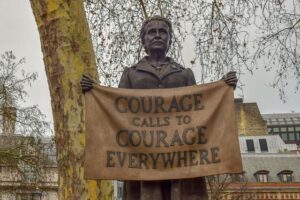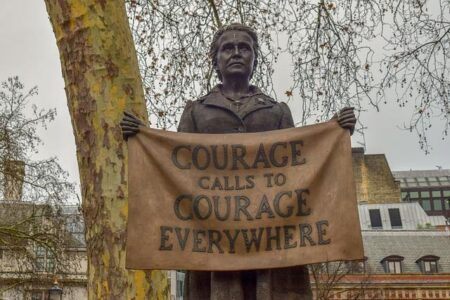Hate crimes in the United States surged to record levels in 2023, raising alarm among communities and law enforcement alike. Experts warn that a convergence of social, political, and economic factors‚ÄĒa “perfect storm”‚ÄĒcould drive these incidents even higher in the coming months. This disturbing trend underscores deepening divisions across the country and highlights the urgent need for comprehensive strategies to address the root causes of hate-fueled violence.
Hate Crimes Surge to Unprecedented Levels in 2023
The year 2023 witnessed an alarming escalation in hate crimes across the United States, marking a grim record that experts warn could worsen. Analysts describe the current environment as “a perfect storm”, fueled by a volatile mixture of political polarization, economic uncertainty, and the rapid spread of misinformation on digital platforms. This convergence has created fertile ground for extremist ideologies and increased targeting of marginalized communities.
Key factors contributing to the surge include:
- Heightened social media influence: Algorithms amplify divisive content, helping hateful rhetoric go viral.
- Economic stress: Inflation and job insecurities stoke scapegoating within vulnerable populations.
- Political rhetoric: Polarized discourse intensifies distrust and emboldens hate groups.
| Region | Year-over-Year Increase | Most Targeted Group |
|---|---|---|
| West Coast | 24% | Asian Americans |
| Midwest | 18% | Jewish Communities |
| South | 30% | Black Americans |
| East Coast | 22% | LGBTQ+ Individuals |
Societal and Political Factors Creating a Perfect Storm
Deep divisions across society have created a volatile backdrop for the surge in hate crimes. Increasing polarization fueled by incendiary rhetoric from some political leaders has emboldened extremist groups and individuals who feel validated in acting on their biases. Social media platforms, while designed to connect, often amplify divisive messages and misinformation, accelerating hostility towards marginalized communities. At the same time, economic hardship and uncertainty have intensified frustrations, making vulnerable groups easy targets for scapegoating.
Several key factors interact to deepen this crisis:
- Polarized media environments: Echo chambers reinforce radical viewpoints and deepen mistrust between communities.
- Policy and law enforcement gaps: Inconsistent hate crime laws and enforcement create loopholes, reducing deterrence.
- Social fragmentation: Declining social cohesion undermines collective efforts to counter hate and build empathy.
- Political opportunism: Some actors exploit divisive issues for electoral gains, downplaying the human cost.
| Factor | Impact | Example |
|---|---|---|
| Media Polarization | Reinforces hostile narratives | Targeted misinformation campaigns |
| Weak Legal Protections | Uneven crime reporting | Loopholes in jurisdiction |
| Economic Anxiety | Increased scapegoating | Job losses in vulnerable communities |
| Political Divides | Legitimizes extremist views | Campaigns exploiting cultural fears |
Communities Most Vulnerable to Targeted Violence
In 2023, particular groups found themselves disproportionately targeted amid an alarming surge in hate crimes. Communities including racial and ethnic minorities, LGBTQ+ individuals, religious groups, and immigrants have been on the frontline of these violent acts. Experts warn that this rise is not random but stems from a confluence of social, political, and economic factors creating what many describe as a “perfect storm.” The data reveals that incidents against these vulnerable groups often involve not only physical harm but also psychological trauma, deeply impacting community cohesion and safety.
Among the most affected, certain data trends emphasize the need for focused intervention:
- Black and Latino communities: A significant increase in racially motivated attacks was recorded in urban and suburban areas alike.
- Jewish and Muslim populations: Religious hate crimes spiked, fueled by rising extremist rhetoric.
- Transgender and queer individuals: Violence motivated by gender identity surged, often in public or social spaces.
| Community | Increase in Incidents (%) | Primary Locations |
|---|---|---|
| Black and Latino | 32% | Urban, Suburban |
| Jewish and Muslim | 27% | Religious sites, Schools |
| LGBTQ+ | 38% | Public spaces, Events |
Strategies and Policies to Combat Rising Hate Crime Rates
To effectively counter the alarming surge in hate crimes, policymakers and community leaders are adopting multifaceted strategies that focus on prevention, education, and enforcement. Key initiatives include:
- Enhanced Hate Crime Legislation: States are updating laws to close loopholes and impose stricter penalties on offenders, ensuring judicial systems hold perpetrators accountable.
- Community-Based Outreach Programs: Local organizations are spearheading efforts to foster dialogue between diverse groups, reducing tensions and promoting understanding at the grassroots level.
- Training Law Enforcement: Specialized training modules equip officers to identify, report, and respond sensitively and promptly to hate-motivated incidents, improving data accuracy and victim support.
- Public Awareness Campaigns: Bold media and education campaigns aim to debunk myths and challenge stereotypes that fuel bias-driven violence.
Data-driven policies have become vital in addressing this complex issue. Below is a comparative framework outlining policy effectiveness across different approaches:
| Strategy | Short-Term Impact | Long-Term Sustainability |
|---|---|---|
| Legal Reform | Strong deterrent effect | Dependent on enforcement consistency |
| Community Outreach | Improved social cohesion | High potential when sustained |
| Law Enforcement Training | Better incident reporting | Requires ongoing refreshers |
| Public Awareness Campaigns | Increased visibility | Needs continual engagement |
Insights and Conclusions
As hate crimes reach unprecedented levels in 2023, experts warn that without concerted efforts from policymakers, law enforcement, and communities, the conditions fueling this surge may persist or even worsen. Addressing the underlying social, economic, and political factors will be crucial in turning the tide on this alarming trend. The coming months will test the nation‚Äôs resolve to confront hate and protect vulnerable populations before the so-called ‚Äúperfect storm‚ÄĚ drives hate-fueled violence to further heights.







